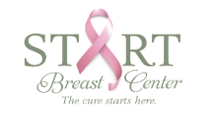Receiving a breast cancer diagnosis can be difficult to deal with, but when you combine this news with pregnancy, it can become overwhelming.
You likely have a myriad of questions and concerns and are fearful because you are dealing with so many unknowns. This event can have a great psychological impact on you and your family, and it is not uncommon to feel anxious, stressed, or depressed during these co-existing events.
A good place to start is by speaking with your physician to find a medical team that has experience in treating pregnant women with breast cancer.
The team you establish should have special knowledge about the timelines of treatment and therapies that will be safe for you and your unborn child.

Pregnancy-associated breast cancer (PABC) can occur any time during pregnancy (prenatal), one year after the birth of your child (postpartum), or during breastfeeding (lactation).
PABC is a relatively rare occurrence, affecting approximately 1 in 3,000 women, with the average age of diagnosis between 32 - 38.
Because it is so rare, few studies have been done to establish best practices and management of care. As more women are delaying childbearing, these numbers could increase, making clinical studies even more important to ensure good oncologic outcomes for the mother and child.
The choice you make about your pregnancy is a very personal decision. You should carefully consult with your partner and medical team to understand all the options available to you in order to make a well-informed decision for yourself.
Some important factors are:
- Pregnancy does not cause breast cancer.
- There is no evidence that cancer can harm your baby.
- Studies show that terminating your pregnancy does not typically improve your chance of survival. Most women who are diagnosed with breast cancer while pregnant choose to get treatment and continue with the pregnancy.
Due to hormone-induced fluctuations during your pregnancy, you may see your breasts go through many changes, making breast cancer hard to detect. Most women reported a lump or palpable mass to their physician, however, other changes to the breast need to be examined more closely:
- A painless lump that won’t go away
- Swelling to the axillary (armpit) area
- Thickening of breast tissue or a dimpling appearance
-
Changes to the nipple area
- pulling inward
- scaling
- redness or changes in skin color
- nipple discharge
If you find changes to your breast(s) that you are concerned about, report it to your obstetrician as soon as possible. They will do a clinical exam and diagnostic workup to determine the cause of these breast changes.
Detecting, diagnosing, and treating breast cancer can be very complex so it will be important that you see your obstetrician regularly for prenatal care as well as get established with a team of breast cancer specialists that can guide and support you through a safe treatment plan.
- Clinical breast exam
- Personal and family history review
-
Genetic testing if you have a family history of breast cancer
- Inherited mutations, such as BRCA 1&2, may put you at a higher riskfor getting breast cancer
-
Imaging
- Ultrasound - frequently used during the prenatal stage of pregnancy because safety to the mother and baby has been established.
- If a suspicious mass is found, a diagnostic mammogram can be done and is considered safe during pregnancy since the small amount of radiation is limited to the breast area.
- For added protection, a lead shield is placed over the lower abdomen that blocks the womb from radiation.
-
Biopsy of suspicious area(s)
- A needle biopsy is a test that removes small pieces of tissue from the suspicious area. A pathologist will then analyze the tissue’s cellsto determine the diagnosis. It can take several days to get the results of the biopsy.
- In some cases, an axillary lymph node needle biopsy may be done due to suspicious findings on the imaging tests.
-
If your diagnostic workup appears to show advanced breast cancer which has spread to other parts of the body, additional imaging may beindicated:
- Chest x-ray with abdominal shielding
- Liver ultrasound
- PET/CT or CT/bone scan or breast MRI in the post-partum period
After your obstetrician has determined how far along you are (gestational age) and a breast cancer diagnosis has been confirmed by a biopsy, they will refer you to a surgeon and/or medical oncologist. These physicians are specialists that will stage your breast cancer. Staging breast cancer helps the physician plan treatment(s) and predict your prognosis.
- Stage I (early stage) – meaning the cancer is small and has not spread toother areas of the body
- Stage II and III – meaning the cancer is larger and has spread to nearby tissue and/or lymph node(s)
- Stage IV (metastatic cancer) – meaning the cancer has spread to other areas of the body
Once staging has been determined, your physician(s) will recommend the safest treatment options based on your clinical scenario. The different types of treatment options include local treatment (surgery or radiation therapy) or systemic treatment (medications given by an intravenous catheter (IV) or by mouth).
The goal of treatment is the same as treating non-pregnant women with breast cancer: to cure the disease and/or prevent it from spreading to other parts of the body. Your team of physicians will collaborate with you to determine the best treatment options.
Local Treatments:
Surgery is a local treatment that is performed by a general surgeon or surgical oncologist. It is proven safe as a treatment option during pregnancy and poses little risk to the unborn child. Your surgeon, anesthesiologist, and obstetrician will coordinate carefully to ensure the safest timing and methods to perform the procedure.
In most cases of early-stage breast cancer with negative lymph nodes, you can proceed to surgery first. In other cases, where the breast cancer is advanced or it is an aggressive type of cancer, surgery will likely be delayed until after systemic treatment.
Timelines of surgery can be complicated and will depend on your particular clinical scenario. As a general guideline, the following is advised:
- First trimester – consider deferring surgery until the second trimester. Speak to your physician(s) about the risks and benefits during this gestational age
- Second trimester – acceptable to proceed with surgery
- Third trimester – acceptable to proceed with surgery
Partial Mastectomy or Lumpectomy

A partial mastectomy, also called lumpectomy, segmental mastectomy, or quadrantectomy is a surgical procedure and is considered “breast-conserving-surgery” (BCS). During a partial mastectomy, the surgeon removes the tumor and a margin of surrounding healthy breast tissue. Axillary staging, a biopsy of underarm lymph nodes, is required in most patients often using a technique called sentinel lymph node mapping.
The goal of a partial mastectomy is to remove the tumor with negative margins, determine if the tumor has spread to lymph nodes, and to preserve the appearance and shape of the breast.
It is important to take into consideration that if you choose BCS, you will likely have whole breast radiation therapy after surgery and the delivery of your baby.
Mastectomy

A mastectomy is a surgical procedure involving the complete removal of the breast. Axillary staging, a biopsy of underarm lymph nodes, is required in most patients often using a technique called sentinel lymph node mapping. The goal of a mastectomy is the complete removal of the breast, removal of the underlying tumor with negative margins, and to determine if the tumor has spread to lymph nodes.
Mastectomies can be categorized into several different types:
- Nipple-sparing mastectomy – the breast tissue is removed preserving the overlying skin, nipple, and areola. This technique is utilized in patients pursuing breast reconstruction. Candidacy for nipple preservation is influenced by tumor location and prior breast surgeries.
- Skin-sparing mastectomy – the breast is removed preserving the overlying skin but removing the nipple and areola. This technique is utilized in patients pursuing breast reconstruction.
- Total mastectomy- the breast is removed along with overlying breast skin, nipple, and areola. A total mastectomy leaves a flat contour to the chest following surgery.
- Modified radical mastectomy – the breast is removed, and an axillary lymph node dissection is performed. See Types of Axillary Surgery for more information on this topic.
Whether you choose to have a partial mastectomy or a mastectomy, the recurrence risk of the cancer spreading to other parts of your body remains about the same for both procedures. For more information on this topic, visit www.breastcancer.org or ncbi.nlm.nih.gov.
Types of Axillary Surgery
The axillary lymph nodes, lymph nodes located in the underarm area, are often the first location of breast cancer spread. Consequently, surgical removal of one or more lymphnodes is often necessary in the staging and treatment of breast cancer*.
- Sentinel lymph node mapping - radioactive dye is injected into the skin of the breast prior to surgery. This dye travels via the lymphatic vessels to the first lymph node(s) draining the breast, referred to as the sentinel lymphnode. This lymph node is identified using a radioactive probe and removed at the time of surgery. The goal of sentinel lymph node mapping is to accurately stage the axilla while limiting the extent of axillary surgery, thereby minimizing the risk of lymphedema.
- Axillary lymph node dissection - surgical removal of lymph nodes within the underarm area. Axillary lymph node dissection is often required in patients whose cancer has spread to axillary lymph nodes, and if required the risk of lymphedema is increased.
*In instances of stage 0 breast cancer, a sentinel lymph node biopsy is often not required. Talk to your surgeon to learn more about sentinel lymph node biopsies and what is recommended for you.
Breast Reconstruction
Breast reconstruction is a surgical treatment option if you choose to have a mastectomy. To learn more about breast reconstruction surgery, ask your surgeon to refer you to a plastic surgeon. They can provide you with information on how they can assist in rebuilding your breast mound(s). The goal of breast reconstruction surgery is to restore your breast(s) appearance and help you feel better about your body and the way you look in clothing after having a mastectomy.
Keep in mind that every woman’s circumstance is different, and the plastic surgeon will discuss the breast reconstruction surgery options that are recommended for you. These recommendations will be based on many factors:
- Stage of the cancer
- Lymph node involvement
- The size and location of your tumor
- The size of your breasts
- Your risk of cancer recurrence
- Personal preference
Radiation Therapy
Radiation Therapy is considered a local cancer treatment that uses high energy x-rays to kill cancer cells and shrink tumors. If this type of treatment is recommended, your physician will refer you to a radiation oncologist, a physician who specializes in the use of radiation therapy to treat cancer.
Treatment is based on several different factors:
- After a partial mastectomy, to help lower the risk the cancer will come back in the affected breast or in nearby lymph node(s).
- After a mastectomy, if the cancer was larger than 5 cm (roughly 2 inches).
- After a mastectomy, if cancer is found in greater than three lymph nodes, however, patients with 1-3 involved lymph nodes may also need radiation.
- After a mastectomy, if the tumor involved the skin or muscle.
- If cancer has spread to other parts of the body.
- Your radiation oncologist will treat only the area(s) that were affected by breast cancer. In some cases, this event may include the axillary area or surrounding tissue. Ideally, the treatment starts about one month after surgery and occurs after you deliver your baby.
Systemic treatment is managed by a medical oncologist who prescribes medications that can be given through an intravenous line or taken by mouth (orally). These medications enter the bloodstream and can target cells anywhere in your body, not just the breast. Systemic treatment can be given before surgery (neoadjuvant therapy) or after surgery (adjuvant therapy) and the timeline of treatment(s) will depend on the gestational age and your clinical scenario.
In advanced stage breast cancer cases, where the tumor is larger and has spread to the lymph node(s) or other parts of the body, chemotherapy may be recommended before surgery (neoadjuvant therapy) to shrink the tumor and prevent it from spreading further.
The type(s) of medications and timelines of treatment will depend on several factors:
- Gestational age
- Stage of the cancer
- Size and location of the tumor
- Prognostic status (estrogen, progesterone, HER2)
- Gene signature tests (a test that analyzes the cancer cell behaviors)
- Patient general health
- Personal preferences
- Hereditary genetic testing

Once your medical oncologist has studied the specific factors involving your breast cancer diagnosis, they will design a treatment plan with specific timelines that are best suited for you and your baby.
The following are types of systemic treatment:
-
Chemotherapy
-
Chemotherapy is typically given to women with more aggressive types of breast cancer, advanced stage breast cancers where lymph nodes or other parts of the body are involved, or patients that are HER2+.
- In advanced stage breast cancer cases, where the tumor is larger and has spread to the lymph node(s) or other parts of the body, chemotherapy may be recommended before surgery (neoadjuvanttherapy) to shrink the tumor and prevent it from spreading further.
- In other cases, your doctor may recommend that you wait to start chemotherapy treatment until after your surgery (adjuvant therapy) and/or after you have delivered your baby.
- Chemotherapy typically isn’t given during the first trimester of pregnancy because it can cause harm to the baby’s developing organs. According to studies, it is safer to infuse chemotherapy during the second trimester and the early weeks of the third trimester.
- In cases where chemotherapy is recommended, your medical oncologist will coordinate closely with your obstetrician.
- It is preferred that you carry the baby to full-term, however, in some cases, your physicians may recommend the baby be delivered before the due date to start or resume treatment.
- Women getting medications for breast cancer are not advised to breastfeed. Chemotherapy can transfer to the breast milk and harm the baby.
- Several medications given for side-effects of treatment are considered to be safe for pregnant women.
- Your baby’s well-being will be monitored closely to ensure a safe outcome.
- If a woman delays treatment due to pregnancy, she may be at higher risk for the cancer to spread.
- Keep in mind, not all breast cancers are treated with chemotherapy. If your cancer has been found early, has favorable prognostics, and has not spread to the lymph node(s) or other parts of your body, you will not need chemotherapy.
-
Chemotherapy is typically given to women with more aggressive types of breast cancer, advanced stage breast cancers where lymph nodes or other parts of the body are involved, or patients that are HER2+.
-
Targeted Therapy
- Targeted therapy is given to women whose cancer is HER2+.
- Targeted therapy is not a type of chemotherapy.
- Anti-HER2 treatment is not considered safe to use during your pregnancy and is to be used post-partum (after birth).
- Women taking medications for breast cancer are not advised to breastfeed. The targeted therapy can transfer to the breast milk and harm the baby.
-
Immunotherapy
- Medicines used to stimulate your own immune system to seek out and destroy cancer cells
- Treatment is not considered safe to use during your pregnancy and is to be used postpartum (after birth).
- Women taking medications for breast cancer are not advised to breastfeed. Immunotherapy can transfer to the breast milk and harm the baby.
- In some triple negative breast cancer (TNBC), immune-targeted therapy may be added to the regimen after delivery.
-
Endocrine therapy
- Oral treatment is given to women that have hormone sensitive breast cancers (estrogen and/or progesterone positive).
- Treatment is not considered safe to use during pregnancy and is to be used postpartum (after birth)
- Women taking medications for breast cancer are not advised to breastfeed. The endocrine therapy can transfer to the breast milk and harm the baby.
Trying to balance your healthcare regimen and family life can become very challenging, making it hard to cope during this difficult time. It is not uncommon to be affected both physically and emotionally.
Remember, you are not alone during this journey. Share your feelings with your partner and talk to your medical professionals about getting support. Studies show that psychotherapy or “talk therapy” has proven value. Speaking with professionals can help validate your emotions and give you clarification by putting these feelings into perspective.
Also, think about joining a local or national breast cancer support group. There are a variety of support groups available in person, online, or through social media that can help you work through your emotions while you go through treatment. Women that have been through this journey can provide a “safe haven” for you with valuable information and guidance and can connect you to resources in your community.
